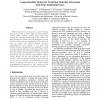Free Online Productivity Tools
i2Speak
i2Symbol
i2OCR
iTex2Img
iWeb2Print
iWeb2Shot
i2Type
iPdf2Split
iPdf2Merge
i2Bopomofo
i2Arabic
i2Style
i2Image
i2PDF
iLatex2Rtf
Sci2ools
ICMLA
2008
2008
Comprehensible Models for Predicting Molecular Interaction with Heart-Regulating Genes
When using machine learning for in silico modeling, the goal is normally to obtain highly accurate predictive models. Often, however, models should also bring insights into interesting relationships in the domain. It is then desirable that machine learning techniques have the ability to obtain small and transparent models, where the user can control the tradeoff between accuracy, comprehensibility and coverage. In this study, three different decision list algorithms are evaluated on a data set concerning the interaction of molecules with a human gene that regulates heart functioning (hERG). The results show that decision list algorithms can obtain predictive performance not far from the state-of-the-art method random forests, but also that algorithms focusing on accuracy alone may produce complex decision lists that are very hard to interpret. The experiments also show that by sacrificing accuracy only to a limited degree, comprehensibility (measured as both model size and classificat...
Related Content
| Added | 29 Oct 2010 |
| Updated | 29 Oct 2010 |
| Type | Conference |
| Year | 2008 |
| Where | ICMLA |
| Authors | Cecilia Sönströd, Ulf Johansson, Ulf Norinder, Henrik Boström |
Comments (0)

